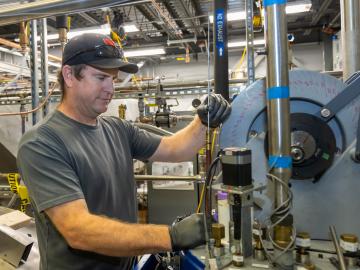Filter News
Area of Research
- Advanced Manufacturing (2)
- Biology and Environment (39)
- Clean Energy (39)
- Climate and Environmental Systems (1)
- Computational Engineering (1)
- Computer Science (2)
- Fuel Cycle Science and Technology (1)
- Fusion and Fission (16)
- Fusion Energy (1)
- Isotope Development and Production (1)
- Isotopes (15)
- Materials (58)
- Materials for Computing (5)
- National Security (18)
- Neutron Science (25)
- Nuclear Science and Technology (13)
- Quantum information Science (1)
- Supercomputing (50)
News Type
News Topics
- (-) Bioenergy (40)
- (-) Biomedical (25)
- (-) Coronavirus (23)
- (-) Cybersecurity (23)
- (-) Frontier (16)
- (-) Isotopes (25)
- (-) Mercury (6)
- (-) Microscopy (25)
- (-) Nuclear Energy (39)
- (-) Physics (41)
- (-) Quantum Science (28)
- (-) Space Exploration (3)
- (-) Summit (22)
- 3-D Printing/Advanced Manufacturing (55)
- Advanced Reactors (12)
- Artificial Intelligence (31)
- Big Data (13)
- Biology (42)
- Biotechnology (10)
- Buildings (21)
- Chemical Sciences (37)
- Clean Water (7)
- Climate Change (36)
- Composites (11)
- Computer Science (69)
- Critical Materials (12)
- Decarbonization (31)
- Education (3)
- Element Discovery (1)
- Energy Storage (55)
- Environment (72)
- Exascale Computing (11)
- Fossil Energy (1)
- Fusion (21)
- Grid (22)
- High-Performance Computing (34)
- Hydropower (2)
- ITER (3)
- Machine Learning (17)
- Materials (65)
- Materials Science (62)
- Mathematics (3)
- Molten Salt (2)
- Nanotechnology (32)
- National Security (32)
- Net Zero (5)
- Neutron Science (57)
- Partnerships (26)
- Polymers (17)
- Quantum Computing (10)
- Renewable Energy (1)
- Security (17)
- Simulation (12)
- Statistics (2)
- Sustainable Energy (44)
- Transformational Challenge Reactor (4)
- Transportation (36)
Media Contacts

Associate Technician Sean Hollander is the keeper of the Fundamental Neutron Physics Beamline, which is operated by the Physics Division at the Spallation Neutron Source at ORNL, where scientists use neutrons to study all manner of matter.

Scientists have uncovered the properties of a rare earth element that was first discovered 80 years ago at the very same laboratory, opening a new pathway for the exploration of elements critical in modern technology, from medicine to space travel.

Mohamad Zineddin hopes to establish an interdisciplinary center of excellence for nuclear security at ORNL, combining critical infrastructure assessment and protection, risk mitigation, leadership in nuclear security, education and training, nuclear security culture and resilience strategies and techniques.

A first-ever dataset bridging molecular information about the poplar tree microbiome to ecosystem-level processes has been released by a team of DOE scientists led by ORNL. The project aims to inform research regarding how natural systems function, their vulnerability to a changing climate and ultimately how plants might be engineered for better performance as sources of bioenergy and natural carbon storage.

Alyssa Carrell started her science career studying the tallest inhabitants in the forest, but today is focused on some of its smallest — the microbial organisms that play an outsized role in plant health.
The United States could triple its current bioeconomy by producing more than 1 billion tons per year of plant-based biomass for renewable fuels, while meeting projected demands for food, feed, fiber, conventional forest products and exports, according to the DOE’s latest Billion-Ton Report led by ORNL.

Two different teams that included Oak Ridge National Laboratory employees were honored Feb. 20 with Secretary’s Honor Achievement Awards from the Department of Energy. This is DOE's highest form of employee recognition.

Corning uses neutron scattering to study the stability of different types of glass. Recently, researchers for the company have found that understanding the stability of the rings of atoms in glass materials can help predict the performance of glass products.
A team from DOE’s Oak Ridge, Los Alamos and Sandia National Laboratories has developed a new solver algorithm that reduces the total run time of the Model for Prediction Across Scales-Ocean, or MPAS-Ocean, E3SM’s ocean circulation model, by 45%.





